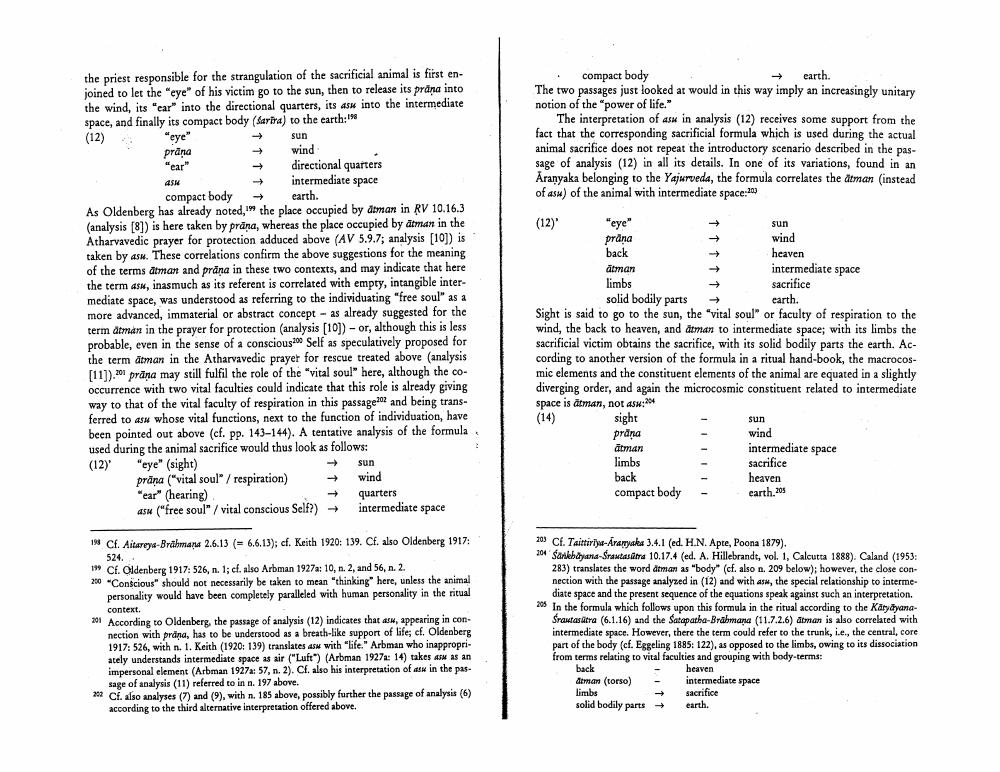________________
. compact body
→ earth. The two passages just looked at would in this way imply an increasingly unitary notion of the power of life."
The interpretation of asu in analysis (12) receives some support from the fact that the corresponding sacrificial formula which is used during the actual animal sacrifice does not repeat the introductory scenario described in the passage of analysis (12) in all its details. In one of its variations, found in an Aranyaka belonging to the Yajurveda, the formula correlates the atman (instead of asu) of the animal with intermediate space:20
11
the priest responsible for the strangulation of the sacrificial animal is first enjoined to let the eye of his victim go to the sun, then to release its prana into the wind, its "ear" into the directional quarters, its as into the intermediate space, and finally its compact body (Sarbra) to the earth: (12) "eye"
sun prana
wind "ear"
directional quarters 458
→ intermediate space compact body earth. As Oldenberg has already noted, is the place occupied by duman in RV 10.16.3 (analysis [8]) is here taken by präna, whereas the place occupied by Atman in the Atharvavedic prayer for protection adduced above (AV 5.9.7; analysis [10]) is taken by asu. These correlations confirm the above suggestions for the meaning of the terms atman and prana in these two contexts, and may indicate that here the term as, inasmuch as its referent is correlated with empty, intangible intermediate space, was understood as referring to the individuating "free soul" as a more advanced, immaterial or abstract concept -as already suggested for the term atman in the prayer for protection analysis [10]) - or, although this is less probable, even in the sense of a conscious Self as speculatively proposed for the term atman in the Atharvavedic prayer for rescue treated above analysis [11]),201 präna may still fulfil the role of the "vital soul" here, although the cooccurrence with two vital faculties could indicate that this role is already giving way to that of the vital faculty of respiration in this passage and being transferred to asu whose vital functions, next to the function of individuation, have been pointed out above (cf. pp. 143-144). A tentative analysis of the formula used during the animal sacrifice would thus look as follows: (12) "eye" (sight)
sun prāna ("vital soul / respiration)
wind "ear" (hearing)
→ quarters as ("free soul" / vital conscious Self?) + intermediate space
(12) "eye"
sun prana
wind back
heaven atman
intermediate space limbs
sacrifice solid bodily parts → earth. Sight is said to go to the sun, the "vital soul" or faculty of respiration to the wind, the back to heaven, and atman to intermediate space; with its limbs the sacrificial victim obtains the sacrifice, with its solid bodily parts the earth. According to another version of the formula in a ritual hand-book, the macrocosmic elements and the constituent elements of the animal are equated in a slightly diverging order, and again the microcosmic constituent related to intermediate space is ātman, not ass:204 (14) sight
sun prära
wind atman
intermediate space limbs
sacrifice back
heaven compact body
carth 205
19 Cf. Aitareya - Brahmara 2.6.13 (= 6.6.13); cf. Keith 1920: 139. Cf. also Oldenberg 1917:
$24. 19 Cf. Oldenberg 1917: 526, n. 1; cf. also Arbman 1927a: 10, n. 2, and 56, n. 2. 200 Conscious" should not necessarily be taken to mean thinking here, unless the animal
personality would have been completely paralleled with human personality in the ritual
context. 201 According to Oldenberg, the passage of analysis (12) indicates that ask, appearing in con
nection with prdna, has to be understood as a breath-like support of life; cf. Oldenberg 1917: 526, with n. 1. Keith (1920: 139) translates as with "life." Arbman who inappropriately understands intermediate space as air ("Luft") (Arbman 1927a: 14) takes as as an impersonal element (Arbman 1927:57, n. 2). Cl. also his interpretation of as in the pas
sage of analysis (11) referred to in n. 197 above. 202 Cf. also analyses (7) and (9), with n. 185 above, possibly further the passage of analysis (6)
according to the third alternative interpretation offered above.
203 Cf. Taittiriy-Aramaks 3.4.1 (ed. H.N. Apte, Poona 1879). 204 Sankabdhyana-Srautasitra 10.17.4 (ed. A. Hillebrandt, vol. 1, Calcutta 1888). Caland (1953:
283) translates the word dtman as "body" (cf. also n. 209 below); however, the close con nection with the passage analyzed in (12) and with as, the special relationship to interme.
diate space and the present sequence of the equations speak against such an interpretation. 205 In the formula which follows upon this formula in the ritual according to the Karydyana
Srautasätra (6.1.16) and the Satapatha-Brahmana (11.7.2.6) dtman is also correlated with intermediate space. However, there the term could refer to the trunk, i.e., the central, core part of the body (cf. Eggeling 1885: 122), as opposed to the limbs, owing to its dissociation from terms relating to vital faculties and grouping with body-terms: back
beaven atman (torso)
intermediate space limbs
sacrifice solid bodily parts earth.




